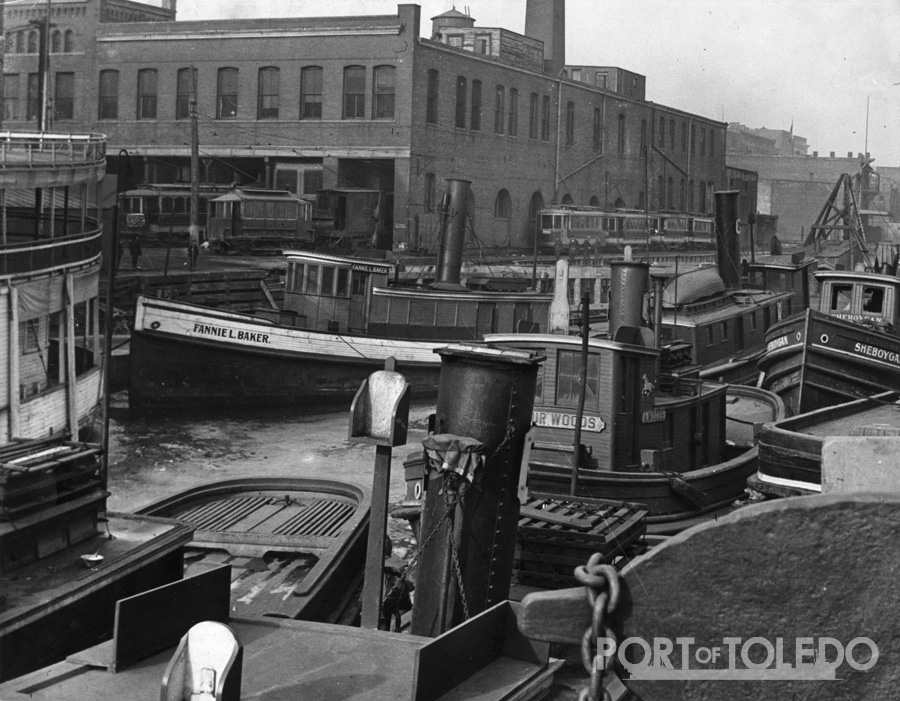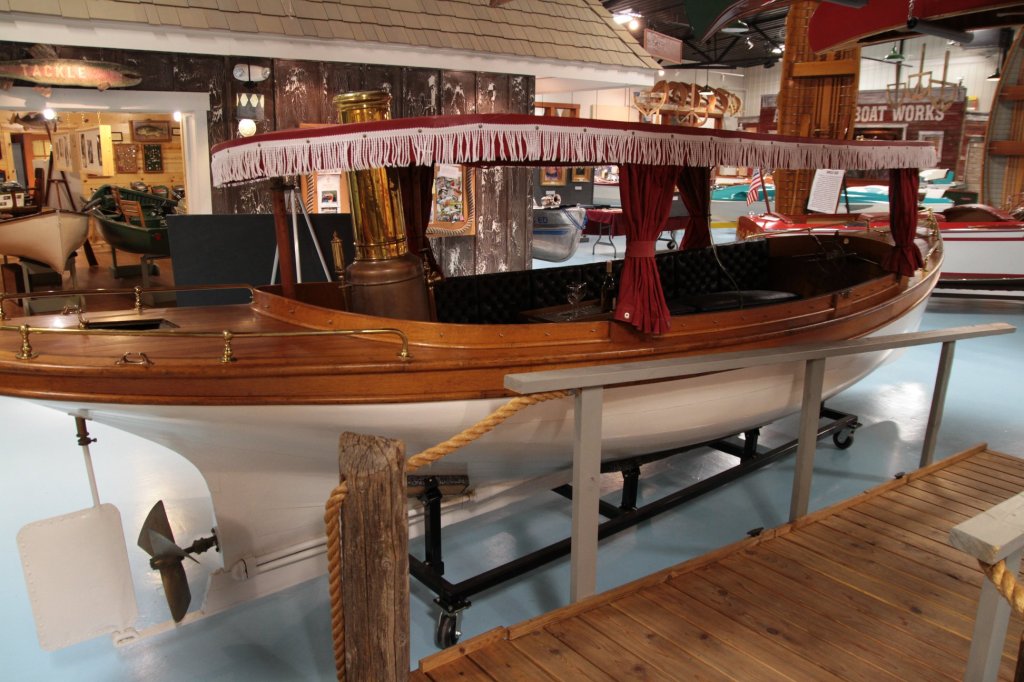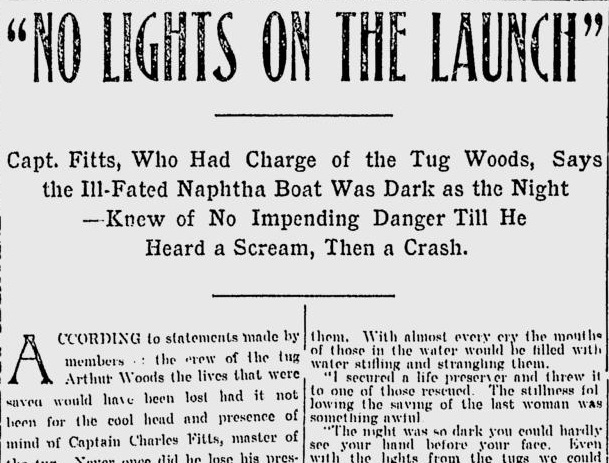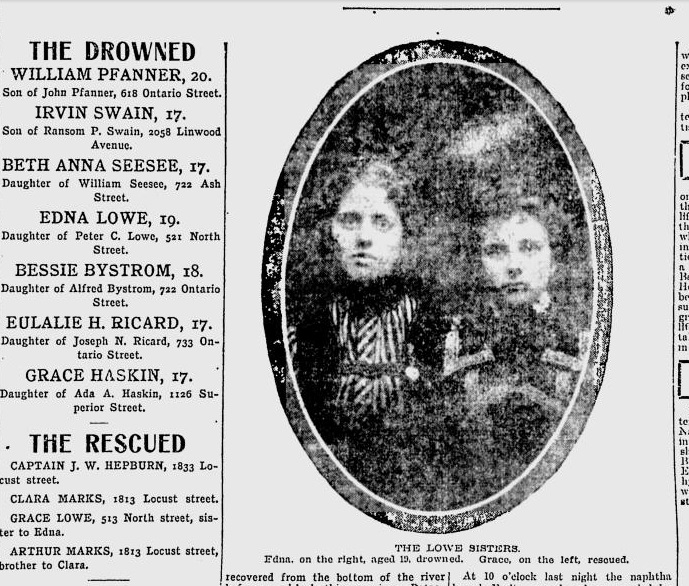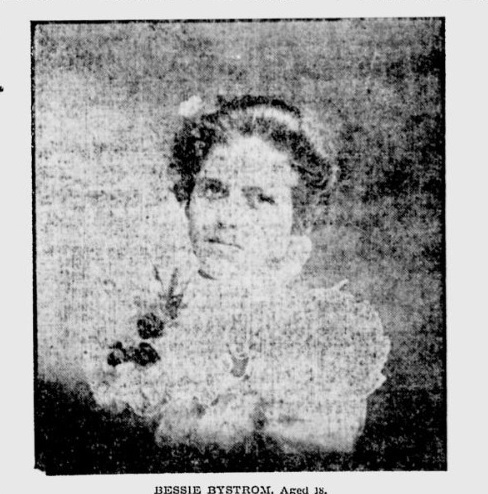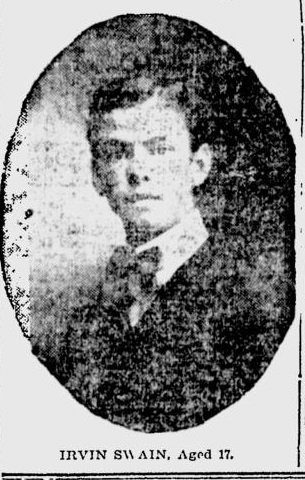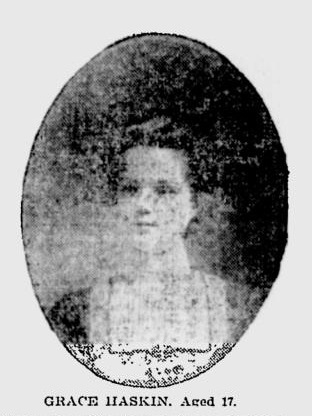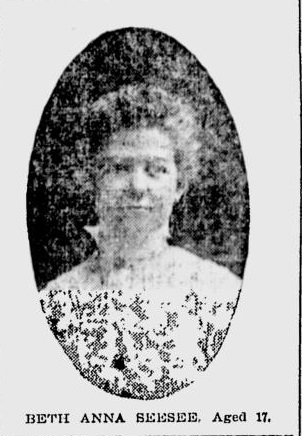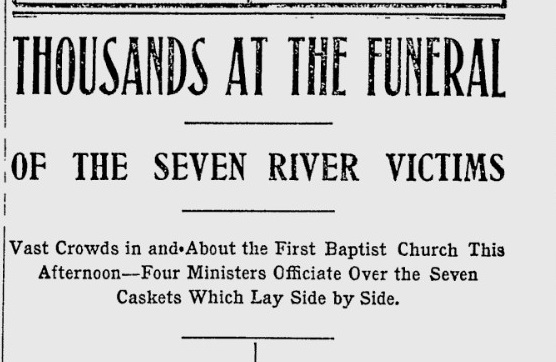The first week of May in 1902 brought a breath of springtime to Toledo. After another long and cold winter, the sun’s warmth cast its spell over the city, in a perennial promise of life renewed. The trees and flowering shrubs were clothed in a bouquet of color, the Maumee River was freckled with a variety of boats and ships, while along the riverbanks, hopeful anglers stood vigil waiting not just for a the pull of a fish or the meal it provides, but for the sheer joy of catching one.
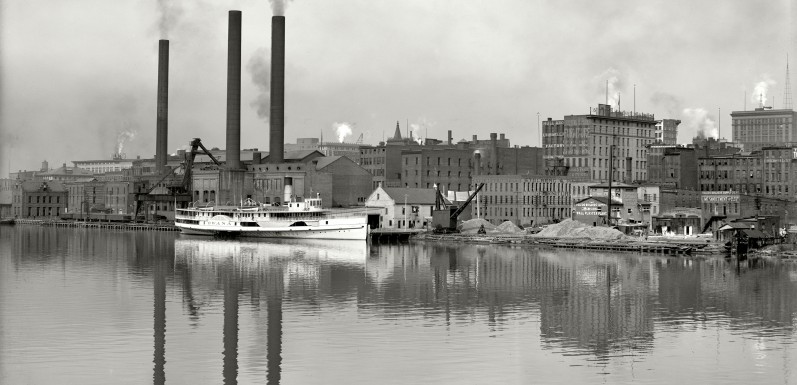
At Armory Park in downtown Toledo, the seasonal rites of baseball were well underway and the Toledo fans had reason to smile. Toledo had beaten Kansas City 7-5. In East Toledo, at Navarre Park, the trails and walkways on the gentle green slopes were filled with the sounds and scents of the season. The heady fragrance of the lilacs hung like a mist, inviting all to breathe deeper from the well of spring. The sweetness matched only by the chatter of children.
But as always with springtime, the weather can be unruly and restless. So too the ephemeral mood of gaiety and gladness. Sometimes a false peace, easily shattered by a sudden spasm of nature that breaks apart a city’s habitat of homes, or shattered by a foolish blunder of man that triggers a tragedy so great, it can break a city’s heart.
And so it was on the night of May 7th, 1902.
A group of Sunday School students, most of them teenagers, from First Baptist Church on Cherry Street in Toledo, climbed aboard a steam powered naphtha launch called the “Frolic on the Maumee River. It was to be a day of pleasure and play. A perfect day for a picnic on one of the nearby islands just beyond the bay in Lake Erie. It was to be a late afternoon-into-evening cruise with the bonus of a wonderful crimson sunset over the water. There were 11 people on board the Frolic, including the Captain and owner of the launch Joseph Hepburn. A man experienced at the helm of the craft who often took people on these excursions to Maumee Bay and the lake. His young passengers numbered ten. Seven young women and girls, all in their teens, several still in high school. And three young men, of similar ages. Two of the girls, Grace and Edna Lowe were sisters. And a brother and sister, Art and Clara Marx, was family with whom Captain Hepburn lived on Locust Street.
One couple, William Pfanner and Eulalie Ricard of Toledo, were engaged to be wed. They sat close to each other, staring into each other eyes as young lovers do. Clasped in each other’s embrace as day ebbed to night and a darkness set in over the waters. The young passengers, by all accounts, had enjoyed their excursion and by 10:00 o’clock that Wednesday evening, Captain Joseph Hepburn was on a heading back to Toledo, steering the Frolic inbound near the mouth of the Maumee River.
Further upstream, a well known tugboat, the Arthur Woods, of the Great Lakes Towing Company fleet, was making its way outbound, or downstream. It was not a huge tug, 55 feet in length and 35 feet at the beam. But it had been working the area of the Toledo docks for about three years pulling and guiding the larger vessels in and out of the docks and slips on the busy shipping channel. At the helm of the Woods was Captain Robert Fitts. Seasoned and well respected. His crew of three, the same. They were headed that spring evening for the slip at Ironville on the east side of the river where they were to dock and drop off a passenger. A woman who had asked Captain Fitts for a ride up to Ironville. It was not a customary practice to carry passengers for transport,aboard the tug, but for some reason, Fitts agreed and she climbed aboard. Little did he know that her presence on the Woods would become an embarrassing scandal for himself and the crew. .
As the Woods progressed downriver and drew closer to the Ironville area near the mouth of the river, Captain Fitts ordered the helmsman to make a starboard turn to the right towards the slip and docks at Ironville. As the tug cut across the channel, Fitts says he saw nothing, nor did he have any indication that any thing or any boat might be in his heading.
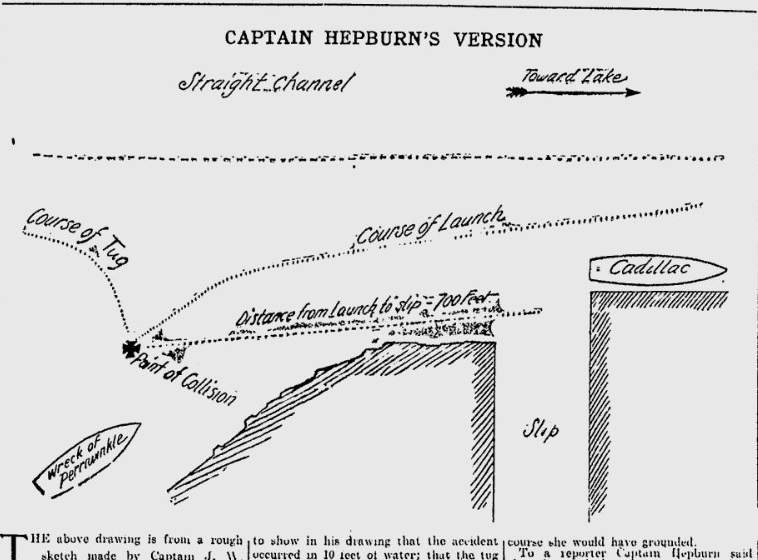
As the Frolic entered the harbor, the girls on the boat were still in a jovial mood from their long day on the water. They broke into song. A marching song, but before their voices could reach the next verse of the song, their voices cracked with horror. Bearing down on them was the bow of the tugboat, and not more than a second or two later, the front end of the Arthur Woods hammered into the side of the Frolic like a giant iron fist. Amidships it was hit, and turned the smaller boat up on its side, as if lifted by a hand, sending everyone on the Frolic into the cold inky water of the Maumee. As written the Toledo Bee on May the 8th, “The black Maumee opened its arms wide and took them deep down”.
The shattered Frolic rolled quickly into the water and within a minute it had vanished beneath the surface, “nothing remained on the ruffled surface of the river except the swaying tug that caused the devastation”. In the first moments of agony, the only things that surfaced were splinters from the Frolic and a few items from , but then, Captain Joe Hepburn, an experienced swimmer, made it to the surface, and Grace Lowe, a passenger also broke the water’s face and she grasped onto Captain Hepburn’s leg in her desperate bid at life itself. Hepburn grabbed Grace Lowe and pulled her close to him. Also a swimmer, 22-year old Art Marx, struggled to rise to the top and counted himself among those who would live, as a would his sister Clara Marx, who somehow found a floating seat cushion on the dark water and clung to it until she, like the other three, were plucked from the water’s grip by the crew of the tugboat. There was no sign of the other seven passengers. Five girls and two boys.. Later reports indicated that most of the girls did not know how to swim and there were no life preservers. It was estimated by some that the water in the river was about 20-25 feet deep at that location.
Captain Charles Fitts told news reporters that as the tug was cutting across the channel the first alert he got was the sound of a scream. At that point he ordered the tug into reverse and then heard a crash and more screams from woman and groans from men. Fitts says he’ll never forget those “bloodcurdling screams”.
No Running Lights on the Launch
He contended that the Frolic launch had no running lamps. No lights at all on a night when any hints of sunlight had long faded away and the sky and water were as dark as black glass. So dark that night, all the light was swallowed up and you couldn’t see the hand in front of your face. After the collision, they tried to shine lamps on the area where the launch went down, but said the lights on the tug were of little value.
Did the launch have a lamp or lantern? The Frolic Captain Joe Hepburn clung to his statement that he did have a light in the aft of the boat. Fitts, the tug Captain, held fast to his claim that there were no lights on any kind on the Frolic.
The search for those answers would have to come later.
Of immediate priority was the search for those who were lost. Survivors or bodies? By midnight, the hope for survival had ebbed to sorrow. The search was not renewed until daybreak the following morning. The search for seven bodies. As news began to circulate through Toledo of the events of the previous night, hundreds of curious onlookers assembled. They knit themselves together along the Ironville docks to bear witness and see for themselves the grim task of reclaiming the victims from their watery crypt. Some of the spectators were from nearby Shantytown along the river bank who gathered as soon as the morbid drama of recovery was underway. Nearby, clumps distraught family members stood and stared out across the water. Holding each other in the chilly morning sun, they studied the movements of the rowboats on the river for any sign that somebody they loved had been found at the bottom.
The reporters from Toledo’s newspapers also joined the curious and family members on the riverbank. Their search was for stories and they found them. They would write that the pastor of the First Baptist Church W.E. Loucks was first informed of the tragedy at six o’clock the next morning by a fellow pastor from another congregation. The Reverend Loucks spent the morning visiting the bereaved family members. He said “it came as a shock to me” and says he has known the families for five years and will do all for them that he can. The scribes from the Toledo Bee made it their mission to find out as much as they could about each victim, so that could attach more than just a name and age to the unfortunate.
A picture of the Lowe sisters was featured the first day in the Toledo Bee, as the two siblings would no longer have each other to confide in or share their future lives. Grace Lowe, by the grace of good fortune was able to survive the ordeal, but not without severe injury to her lungs and her heart. She was said to be hysterical with grief the following morning in knowing that her beloved sister, Edna Lowe, 19, was never to surface alive after she fell into the water’s unmerciful grip.
Irwin Swain was just 17, a freshman in high school. Well liked and admired by many. His desire was to be an artist as he loved to sketch. He left many of his drawings lying about the house and his forlorn mother will have them to remember him by.
Bessie Bystrom was 18, an active Sunday school member and a clerk at a local grocery store. Her father an engineer at the Nasby Building.
Beth Ann Seesee, only 17, was described as a tall slim girl with beautiful brown hair and black eyes. She was loved by all who knew her.
Grace Haskin, 17, also a student at the high school was well liked and an active participant in her church. Ironically, her father had drowned in a launch accident on the river, just two years prior.
And then there was the poignantly sorrowful story of William Pfanner, 20 and Eulalie Ricard, 19. They were engaged to be married. He was working as a teller for Ohio Savings while his fiance Miss Ricard had graduated high school and Ursuline Convent and was active in Sunday school. Witnesses said they ran to each other as they saw the approaching tug and went to their death wrapped in each others arms. Miss Ricard was the cousin of victim Bessie Bystrom.
In the course of the next few days, there was no shortage of stories and remembrances about this river tragedy to feed the appetites of inquiring minds. There were of course the many questions that still lingered about what happened that night. How could the tug not have seen launch? Both captains, Fitts and Hepburn clashed publicly about whether the launch was displaying a running light. Tug captain, Charles Fitts was adamant that the launch had no such lamp or light. Captain Joe Hepburn was equally as adamant that they did. And he also accused the tug captain of taking a hard starboard turn that put the heavy tug on a collision course with their much lighter and vulnerable launch. An inquest into the vexing questions about the reasons for the tragedy would provoke even more questions. The identity of the woman said to be on board the tug was not known. The tug captain, Charles Fitts at first denied there was a woman on board. But other witnesses claimed to have seen her and she was reported to be drunk and amorous with the tug’s fireman. And during inquest testimony it was revealed by the tug’s fireman that he tried to make love to the mystery woman that night, but she rebuffed his advances. These sordid details may have had little to do with the cause of the accident, but in the black of white of newsprint, they helped sell newspapers. Not everyone was impressed with the sensational reporting in Toledo’s daily papers. A federal officer brought in to survey the damage and investigate the accident labeled the reporters as “newspaper leeches” and advised the people involved not to talk with them.
But that didn’t deter the reporters’ efforts to search for new revelations. Each new day seemed to bring new narrative of the human pathos that had played out on the river’s stage. Clara Marks, one of the four who managed to endure the torture of near drowning, did not survive easily. Her personal account in the Toledo Bee two days later was vivid.
“When the tug struck the boat, the side away from me went up in the air, and then I jumped off. I went down, down , down. I thought I would never stop going down. It was so black and cold. Then all of a sudden I seemed to stop. My lungs were bursting. I waved my arms, but they moved so slowly, as if a great weight was tied to them.”
The reporter who took her narration noted that Clara talked in a monotone and her skin was still white, and that water from the river was still in her lungs.
” I never swam before, but I kicked my legs and waved arms.” “I went to the surface, my throat and lung filled with cold water.” Within seconds she went down again. “I went down three times,” she said quietly. “I know that when I went down for the third time, that it was all over. And that I would not have to struggle any longer. It was a blessed relief.”
On her third time resurfacing she found a seat cushion, filled with cork, floating in the water and clutched it. It kept her afloat until she was finally rescued by her cousin Art Marks who swam to her in the darkness and was able to guide her through the water to be pulled aboard the Arthur Woods tugboat. Once aboard the tug Marks helped turn the victims, face down, to force them to expel the water in their lungs. A hero for the moment. The The Toledo Bee,said surely he should be ascribed that status.
And as every tale needs a hero, such heart rending horrors are sure to bring those forward who say they were “almost” victims. Such was the case of Pearl Miller, an 18 year old from the First Baptist church whose father strongly suggested he not go on the the Frolic excursion because it might be dangerous and he could die in there was an accident. Was it a premonition? Whatever the genesis of his father’s fear, young Pearl did not climb aboard the Frolic that day. He says that if he had, he probably would have drowned, for he can not swim.
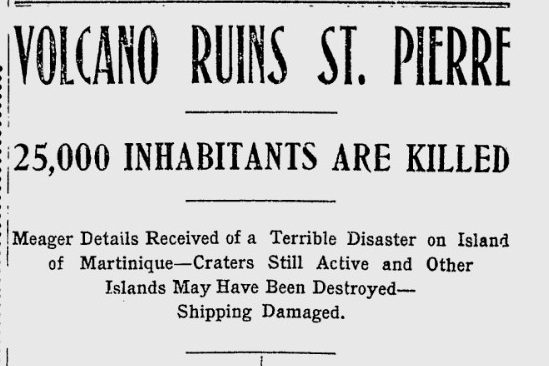 Ironically, as if one tragedy to unfold in the headlines that week of 1902 was not enough to absorb, the day after Toledo’s terrible river tragedy, came word of catastrophic volcanic eruptions in the West Indies on the islands of Martinique and St. Vincent. Not one but two volcanoes erupted within hours of each other. Both were deadly, but the eruption of Mt. Pelee at Martinique was mind numbing with over 25,000 dead at St Pierre, essentially the entire city caught in the mountain of molten lava that mushroomed down the slope burying everything in the path. The earth’s convulsions spared few from he wrath of fire and rock. The stories did not need any florid embellishments, for the reality was sensational and horrid as the mind’s eye could envision. Toledo’s river horror would share ink and front page headline space with this seismic event of human calamity for the next week. The astonishing events in the Caribbean did little to impede or diminish the coverage of the the Frolic accident on the Maumee River and the full spectrum of the community response to it.
Ironically, as if one tragedy to unfold in the headlines that week of 1902 was not enough to absorb, the day after Toledo’s terrible river tragedy, came word of catastrophic volcanic eruptions in the West Indies on the islands of Martinique and St. Vincent. Not one but two volcanoes erupted within hours of each other. Both were deadly, but the eruption of Mt. Pelee at Martinique was mind numbing with over 25,000 dead at St Pierre, essentially the entire city caught in the mountain of molten lava that mushroomed down the slope burying everything in the path. The earth’s convulsions spared few from he wrath of fire and rock. The stories did not need any florid embellishments, for the reality was sensational and horrid as the mind’s eye could envision. Toledo’s river horror would share ink and front page headline space with this seismic event of human calamity for the next week. The astonishing events in the Caribbean did little to impede or diminish the coverage of the the Frolic accident on the Maumee River and the full spectrum of the community response to it.
The coroner’s inquest, the mystery of the unidentified woman reported to be aboard the tugboat, and descriptions of how the victim’s families were coping all kept Toledo readers flipping the pages and drying their eyes. The story of the funerals was especially mournful. On Saturday May 10th, inside the sanctuary of the First Baptist lay seven caskets , side-by-side. The first time such a scene of this type and size had ever been witnessed in the city. The church itself was awash in clouds of floral beauty and fragrance as greenhouses in the city emptied their storage rooms of flowers and banked them in layers around the caskets. Hundreds of friends and family crowded the pews and stood near the coffins, as family members were given a chance for last last look and a chance to say goodbye. There were also hundreds of others who were strangers, affected curious who came to pay their respects and to be a part of this most solemn event. Extra rooms and the church vestibule were opened up to help accommodate the sea of people, many of whom wept openly, as others talked quietly about the investigation and who was to blame. The voices of a special quartet floated over the pews with song and hymns, keeping the mood somber. Outside, the skies had turned gray and cloudy. Cool and gloomy, fitting the mood of the afternoon.
Each coffin had its own set of pallbearers. Most were family or school friends. A poignant moment was observed as it was noted that all six of Beth Ann Seesee’s pallbearers were girls. Classmates. After the services, the caskets were taken that Saturday to Woodlawn and Forest cemeteries. Will Pfanner’s body was the only one to be interred at Woodlawn. The other six were taken by carriage to the Forest Cemetery.
The Burials at Forest Cemetery Turned Into a Mob Scene
It was at Forest where the mood of the mourners began to shift. Hundreds of other people joined those arriving caravan and according to news accounts, the scene devolved into one of chaos and disrespect. As news accounts described it, “Not less than 2,000 people gathered at Forest Cemetery to witness the internment of six of the young people who drowned Wednesday night…” The Sunday morning Toledo Bee called most of them “sensation seekers filled with morbid curiosity.” who laughed and joked as the six hearses slowly rolled into the cemetery. They were so unruly, they pushed and shoved and nearly caused some mourners standing on the edge of the graves to be “pushed into the cavity”. As the narrative of the burials continued, it noted the gray skies that brooded overhead and a sharp chill in the air as rude behavior of the curious continued. Miscreants who trampled fresh graves and tombstones as they rushed from one grave to another of the Frolic victims, stealing flowers and relics. A spectacle that disgraced the saddest funeral the city has ever known.
The next day, a similar scene played out once again at Forest as more of the irreverent made a pilgrimage into the graveyard. A Bee headline opined with chiding indignation, that all that was needed to make it a circus were “peanuts and popcorn”.
Mystery Woman Aboard the Tug Identified
With the victims at rest for eternity, the questions and controversy of the wreck were not close to being put to rest. The inquest was still underway and with each new day, new revelations broke the surface. One of the revelations came that Monday following the accident as the mystery woman was finally identified, In fact she freely admitted to it. Nellie Armstrong who lived at the Suburban Hotel on Water St. said she was the woman who got aboard the tugboat that night and was aboard when the accident happened. She was also identified by a man who says he was drinking with her in an Ironville saloon after the accident happened and she got off the tug. Nellie proved to be at ease on the witness stand and was described as glib and talkative. She said she had hitched a ride with the tug boat from the Jefferson Street docks so she could apply for a job as cook with one of the boats docked at Ironville. She asked tug captain Charles Fitts for a ride and he said, “Sure, hop on board.” One of the girls who survived the ordeal said after getting on board the tugboat, she saw Nellie Armstrong and asked her to help her out of her wet clothes, but the woman swore at her and refused to help.
The tug’s crew had lots of questions to answer about the events that happened just after the collision. One allegation made at the inquest was the Captain Hepburn of the Frolic, an experienced and excellent swimmer, wanted to jump back into the Maumee River waters to see if he could rescue any other passengers. But, he says the crew of the tug would not allow him to do it. Why they didn’t let him was a point of contention with tug captain Fitts stating that Hepburn said was going to jump into the water again with the intention to commit suicide. The tug fireman, William Smith agreed with the captain, but the tugs engineer, Charles Williams said he only heard Hepburn say he wanted to get back in the water to “save the girls”.
Captains of Both Vessels Held to Account
Why more of an effort was not made by Charles Fitts, the Captain of the Arthur Woods, to rescue the victims of the Frolic, or at least make an effort to that end, is not clear. For many it was a haunting question mark for Fitts had a reputation for heroics in water rescues. Charles A. Fitts, was one of the most reliable pilots of the Maumee. Born in Toledo in 1872, he was the son of Captain Albert S. Fitts and had been around the lakes all of his life. As a younger man, he was a man of magnificent physique and strength. Athletic and aa little above the average height, he was regarded as a pleasant speaker and companion. His muscles according the friends and shipmates were like iron, and he was a strong swimmer. He aspired to be a pilot of Great Lakes steamers, like his father, and after leaving high school, he did so. Either working as a wheelsman or pilot on a variety of steamers including the Pastime which his father had sailed out of Toledo for a number of years. While on the hurricane deck of the Pastime,one day on the Maumee, he saw a boy fall off the dock. Fitts jumped overboard and swam to the boy who was near his last breath, and pulled him ashore, where he was resuscitated. His next rescue was at the foot of Jefferson street in Toledo. Three young men were on a small yacht when one them was swept off when he was hit by the main sail boom. He struggled helplessly in the water until Fitts swam out and succeeded in landing him on the deck of the Pastime where the young man recovered. Just why Fitts himself did not leap at the opportunity to help these struggling souls on that night in May of 1902 is silent to history. A question that would later become a part of the official ruling from investigators.
The inquest did not end quickly, the coroner conducting the proceeding was deliberate and methodical about gathering the evidence to determine where the blame might lie. A question that once determined could result in a wave of litigation against either the tug or the launch. A week after the accident, the coroner was taken to the scene of the collision on the river at Ironville. He wanted to see and judge for himself the supposed location of the vessels and who should have yielded to whom. Measurements and river depths were recorded and there was disagreement between the two captains as to where exactly each vessel was at the moment of impact. The coroner eventually said he has enough information and would make a ruling in a couple of weeks. In the meantime, the news and immediate excitement about the tragedy began to wane. The story was dropped from the front page and the city residents turned their attention to other and newer stories of interest.
A labor strike at Rossford’s Ford glass plant and at least five other factories idles thousands, the death of “Mary Ann the Gun” a once notorious pickpocket in Toledo, the Toledo arrest on “general principles” of a white man and black woman for their relationship, and the efforts by developers to build a new housing project near the zoo called Harvard Terrace.
This tragedy did keep some people focused on boat and water safety. There was an short story on how the river tragedy triggered a sudden demand for lights for boats and some shopkeepers said they were already sold out of the lamps. There was also a public demonstration at Walbridge Park of a new type of life preserver that promised better personal safety. It used inflated inner tube devices to keep people afloat in the water should they fall out of a boat. But sadly in the weeks that followed the accident there would be several more drownings on the river. Either from fishing boats that capsized in the currents, or children lured by the call of the cool water. Another summer when the river’s witch becomes a cruel temptress.
But the river is never blamed for its cruelty. The boat captain involved were left to fret as to which one of them might shoulder that burden of blame. The anxiety and the stress of the accident and the pending ruling began to take its toll on launch Captain Joe Hepburn, within two weeks after the disaster he resigned as head of the Toledo Yachting Association’s regatta committee, saying that he was no longer physical able to withstand the duties of the job. He is in such a state that he is in “no condition to participate in anything resembling festivities”
On May 27th, Coroner Storz finally ruled that neither skipper was to blame for the tragedy that took seven lives. Storz essentially sidestepped a final judgment as who was at fault, and relinquished that obligation to the Federal government, letting “Uncle Sam fix the blame”. In his Storz’s ruling he said he did not find either captain “to be liable for criminal negligence.” He also ruled that he couldn’t determine if the presence of woman passenger on board the tug was a contributing factor. He did write that he was surprised that more of the victims could not have been rescued, although he explained that might have been attributable to the “excited state of the tug crew” at the time.
In the end he implored other watercraft operators to be more careful, to be ready for emergencies and said he would leave it to the jurisdiction of the United States government to make a ruling.
Within a day, that ruling from the Customs office came and contradicted the coroner’s results. Colonel Bonner of U.S. Customs found both captains guilty and each should bear some blame for the deadly tragedy. The tug captain Charles Fitts was fined $500 for violating the rules by allowing a woman passenger on board the tug that night, and for operating with one crew member short, and without an adequate lookout for any impending hazard on the river. Colonel Bonner also ruled that Captain Joe Hepburn was not without fault, and was fined $200 for not having running lights on his naphtha launch, the Frolic, and that his craft also should had someone keeping watch for possible hazards in the darkness.
Epilogue
The rulings came the same week in 1902 as Toledoans were ready to observe Decoration Day, what we now call “Memorial Day”. Dutifully tens of thousands of people took carriages or walked or took a trolley to area cemeteries to pay their respects to those who died or served their country in the Civil War, and other wars in the nations history. Flags flapped in the breeze, bugles played, preachers prayed and everyone stopped if only for moment to absorb and reflect. School children, at the urging of teachers and veterans, gathered flowers to scatter over the graves of those who had fought their last battles. Forest Cemetery hosted the largest numbers of pilgrims who came to give their solemn thanks. Many of whom no doubt saw the fresh mounds of earth piled atop the new graves of six young people who perished when the Frolic launch flipped and discarded them to the bottom the river. Likely pausing to ponder the young lives who futures were robbed by the whim of circumstance. In time, however, the mounds of loose clay would subside and grass would grow over them and headstones would appear with etched names, so the living would not forget who they were. But, as always, memories do wither with the seasons. Perhaps not for the families and close friends, but those others who knew them only by their notoriety of death. Time and memory move on. There would be other tragedies, large and small, sensational and similar to ensnare the attention span of the public.
Maumee River A Lethal Seductress
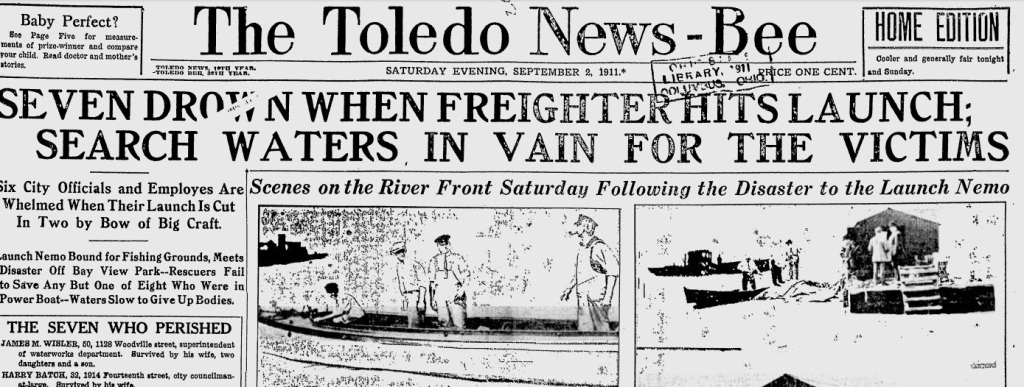
Ironically, nine years later in 1911, on September 2nd, seven people, six of them Toledo city officials and employees, were also sent to the murky depths of the Maumee when their 35 foot fishing boat “The Nemo” was rammed by the bow of a freighter, the “Philip Minch”. This calamity too rendered weeks of journalistic and public fascination. But it too eventually faded to a footnote in Toledo’s past.
In, a similar tragedy would play out again when in 1930, eight prominent Toledo men mysteriously went to their deaths when they were flung from their high speed Dart boat into Lake Erie. The victims were on a night run from Toledo to Pelee Island in Canada for an Elks party. As the sped across the dark waters of the lake, something caused the sleek wooden speed boat to flip and pitch them into the black water of eternity. The story was charged with mystery and high intrigue for weeks and then the story’s sharp focus slowly faded into the mist.
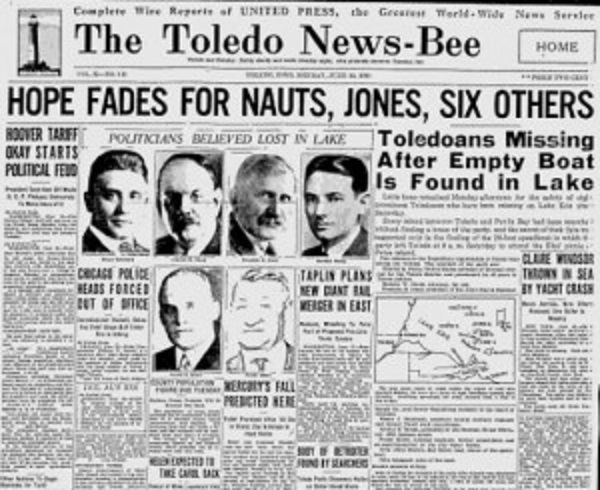
More than 100 summers have passed since the night in late spring of 1902 when what should have been a routine non newsworthy pleasure cruise turned into a horrible episode in the city’s history. However, much has changed since then. Steam launches are no longer seen on the river, replaced by gas powered pleasure craft. The community of Ironville is gone and so are the docks, at least as that generation knew them. First Baptist Church on Cherry Street later became a homeless mission and during urban renewal, torn down. And most of the city’s newspapers of that day, including the News Bee are gone too. The ink and its pages though, preserved in digital form, are able to reveal to readers volumes of history and this Toledo tragedy. The only tangible physical evidence enduring is found in the city’s cemeterys, Woodlawn and Forest. Here one can still find the graves of the seven victims and even the latter graves of some survivors. At Forest, the markers of those lost were joined by the tombs of the two boat captains , Joe Hepburn and Charles Fitts. Two men of water, joined for eternity in a sea of earth. Nearby one can find also the final homes of the victims’ family members, and friends who bore the sorrow and memories. Buried with them, no doubt, their burden of tears and torment.
Yes, much has changed. And much has not.
Now on a sunny spring day, as it was May 7th, 1902, the leaves in the green canopy at Forest still rustle overhead in the soft breezes that curl among the weathered headstones, whispering to all who hear them, the stories that time won’t forget.
.




